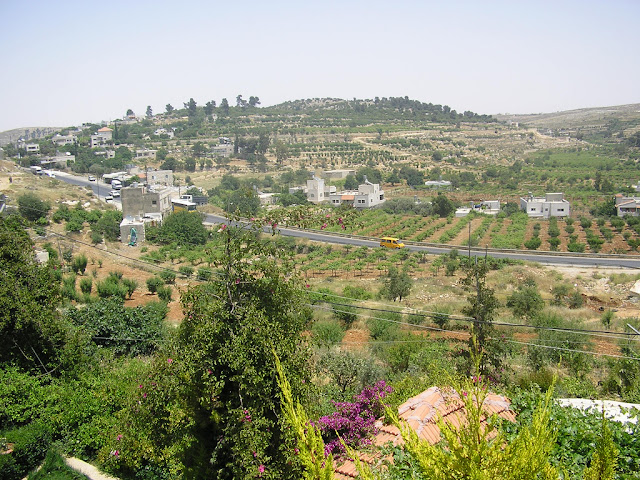By Miri
Beit Ummar is a town situated between the cities of Hebron and Bethlehem in the beautiful and fertile central highlands of the West Bank.
In Palestine, like everywhere, each and every place has its very own and particular story, at the same time, however, Beit Ummar’s condition in a way constitutes the Occupation in a nutshell.
Since 1967, five ideological settlements were built on Beit Ummar’s land, for which approximately 4,000 dunums were seized and numerous houses were demolished. Like in other places, the presence of settler communities bring with it the establishment of a whole security apparatus. During the course of the years, bypass roads to the settlements, security gates, as well as checkpoints and a tall watch tower overseeing the main entrance to the town and monitoring everyone entering and leaving, were built and hence allow the army to restrict the movement of Beit Ummar’s 17,000 residents.
Again, just like in so many other places in the West Bank, approximately 60% of Beit Ummar’s residents rely on agriculture for their living. With the continuous expansion of the settlements, more and more land is being seized, and thousands of grape vines and stone fruit trees, typical for the area, have already been uprooted. Beit Ummar used to have a reputation for hosting the largest fruit market in the southern West Bank. With the loss of the trees, however, and especially with the Israeli army blocking the entrance to the market, Beit Ummar’s fruit farmers were forced to sell what is left of their crops alongside Route 60 to passing traffic.
Faced with the theft of their lands and the repression of their lives, the residents of Beit Ummar chose not to remain silent, and by now look back at a long history of involvement in popular resistance, including during the First and the Second Intifada. During clashes with the Israeli army, as well as with violent settlers, many residents were injured or killed, and hundreds are still held in Israeli jails.
Since the end of the Second Intifada, activists all over the West Bank have been trying to move back to earlier models of political organising that transcend political affiliation and combine unarmed struggle with social programmes and support. Aligning themselves with other activists from the region, the activists from Beit Ummar particularly focus on activities that broach the issue of farmers’ rights and access to their lands. Their weekly activities include the accompaniment of farmers who are threatened by settler violence, the replanting of uprooted trees, as well as the farming of lands in danger of being seized by the Israeli army.
 |
| Mousa at court with his fiancee and PSP co-founder Bekah Wolf, 2008, Photo ActiveStills |
It is also in Beit Ummar that one of Green Olive Tours’ partners, the Palestine Solidarity Project (PSP) was founded in 2006. The PSP dedicates itself to “opposing the Israeli occupation of Palestinian land through non-violent action” and also facilitate the involvement of international and Israeli solidarity activists into the local struggle.
Mousa Abu Maria, a co-founder of PSP and frequently hosting participants of Green Olive Tours, had to pay a high price for his political work and spent nearly five years in prison, 14 months of which he was kept under administrative detention, meaning without charges or a trial. Carrying on with his work after his release in 2009, the Israeli authorities keep on threatening him and his family, as well as other Palestinian activists from Beit Ummar with further arrests.
In order to learn about the situation in Palestine and Israel one can (and should) engage with and delve into literature, articles, lecture, documentaries etc. None of this can however substitute for encounters with the people who call Occupation their everyday reality. Nothing will get you closer to an understanding of the complexity of the situation on the ground than engaging with, and especially listening to the stories of the people who live it.
Green Olive Tours provides you with the opportunity to stay and get to know Beit Ummar and its residents. For more information, click here


Comment (0)